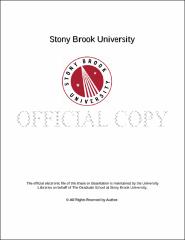| dc.identifier.uri | http://hdl.handle.net/11401/77426 | |
| dc.description.sponsorship | This work is sponsored by the Stony Brook University Graduate School in compliance with the requirements for completion of degree. | en_US |
| dc.format | Monograph | |
| dc.format.medium | Electronic Resource | en_US |
| dc.language.iso | en_US | |
| dc.publisher | The Graduate School, Stony Brook University: Stony Brook, NY. | |
| dc.type | Dissertation | |
| dcterms.abstract | Two empirical regularities of bank lending practices stand out: interest rate spreads on loans and lending standards both are lower during booms than in recessions. I provide a unified explanation of these two facts, stressing procyclical competition of the banking sector as the driving force. I first develop a game of bank lending with screening. Borrowers have private information about the creditworthiness of their projects. Banks rely on a screening technology to distinguish good projects from bad ones by choosing the screening intensity, which I identify with the lending standards. Because screening is costly, in the optimum the screening intensities chosen by banks are always less than perfect. Moreover, the screening intensity, and hence the lending standards, determined in this way are positively correlated with the profitability on loans. Next, this lending game is repeated over time, and a bank's payoff is affected by various aggregate shocks which capture various aspects of the business cycle. I show that in the optimal subgame perfect equilibrium of this repeated game, better business conditions during booms increase a bank's incentive to deviate ceteris paribus, thus forcing banks to compete more to shrink the profit margin and to restore the equilibrium incentive constraint. As a result, banks charge lower interest rates and impose looser standards during booms, while the opposite happens during recessions. I proceed to extend the basic framework to incorporate time-varying risk-free rates. This provides a convenient way for modeling the risk-taking channel of monetary, in which I can study the joint dynamics of bank competition and lending standards as responses to variations in the risk-free rate. The main model predictions lend strong supports to the perception that the historically low risk-free rate during the final years of the Greenspan era (2002--2005) is an important source of the credit boom, especially the very low lending standards, right before the subprime crisis. | |
| dcterms.available | 2017-09-20T16:52:40Z | |
| dcterms.contributor | Carceles-Poveda, Eva | en_US |
| dcterms.contributor | Anagnostopoulos, Alexis | en_US |
| dcterms.contributor | Brusco, Sandro. | en_US |
| dcterms.creator | Liu, Yan | |
| dcterms.dateAccepted | 2017-09-20T16:52:40Z | |
| dcterms.dateSubmitted | 2017-09-20T16:52:40Z | |
| dcterms.description | Department of Economics. | en_US |
| dcterms.extent | 77 pg. | en_US |
| dcterms.format | Monograph | |
| dcterms.format | Application/PDF | en_US |
| dcterms.identifier | http://hdl.handle.net/11401/77426 | |
| dcterms.issued | 2014-12-01 | |
| dcterms.language | en_US | |
| dcterms.provenance | Made available in DSpace on 2017-09-20T16:52:40Z (GMT). No. of bitstreams: 1
Liu_grad.sunysb_0771E_11910.pdf: 629533 bytes, checksum: 95c6cd073b7cb8a68193524aca6b1368 (MD5)
Previous issue date: 1 | en |
| dcterms.publisher | The Graduate School, Stony Brook University: Stony Brook, NY. | |
| dcterms.subject | Economics | |
| dcterms.title | The Macroeconomics of Bank Competition over the Business Cycle | |
| dcterms.type | Dissertation | |

